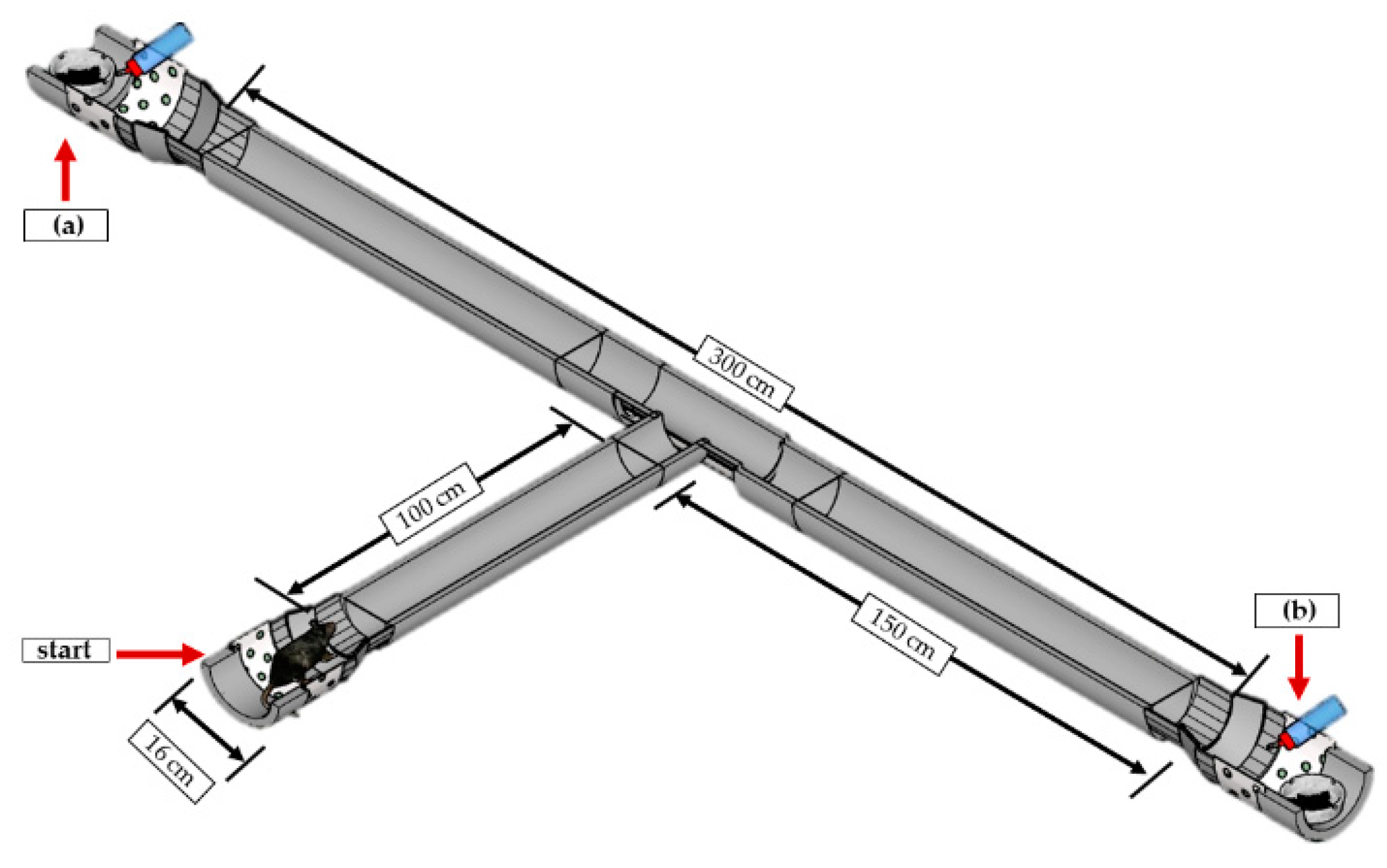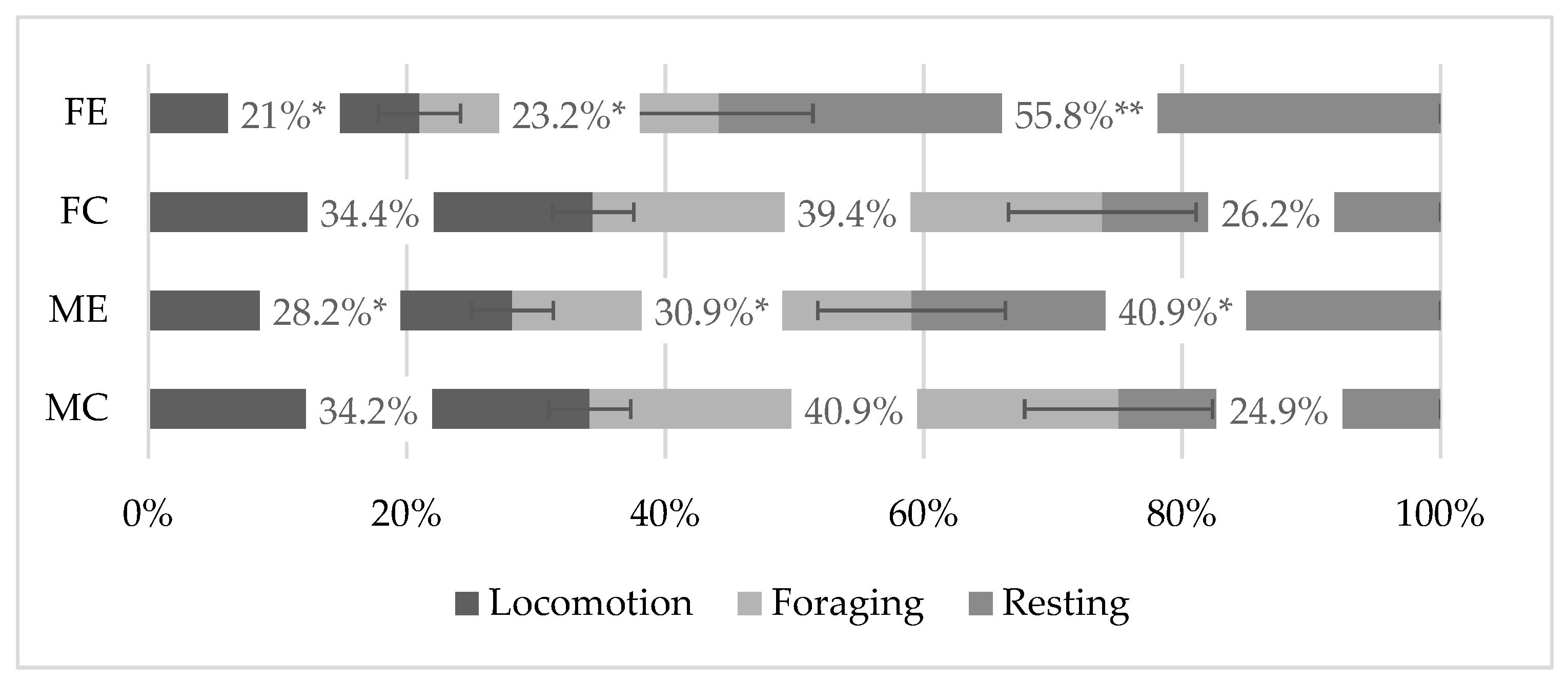Effects of Oleander Leaves (Nerium oleander) against Metabolism, Activity Pattern, and the Leaves Potency as Rice-Field Rat Repellent (Rattus argentiventer) †
Abstract
1. Introduction
2. Experiments
2.1. Study Site
2.2. Rice-Field Rats
2.3. Plant Materials and Extraction
2.4. Choice Test in T-Maze
2.5. No-Choice Test in Metabolic Cages
2.6. Data Processing and Analysis
3. Results
3.1. Choice Test in T-Maze Arena
3.2. No-Choice Test in Metabolic Cage
3.2.1. The Effect of Oleander Leaves on Rice-Field Rat Metabolism
3.2.2. The Effect of Oleander Leaves on Rice-Field Rats’ Daily Activities
4. Discussion
5. Conclusions
Supplementary Materials
Author Contributions
Funding
Acknowledgments
Conflicts of Interest
References
- Tristiani, H.; Murakami, O.; Watanabe, H. Ranging and nesting behavior of the ricefield rat Rattus argentiventer (Rodentia: Muridae) in West Java, Indonesia. J. Mammal. 2003, 84, 1228–1236. [Google Scholar] [CrossRef][Green Version]
- Sudarmaji; Herawati, N.A. The development of the rice field rat population in irrigated rice fields in the rice crop index pattern of 300. Penelit. Pertan. Tanam. Pangan 2017, 1, 125–132. [Google Scholar] [CrossRef]
- Sullivan, T.P.; Sullivan, D.S.; Crump, D.R.; Weiser, H.; Dixon, E.A. Predator Odors and Their Potential Managing Pest Rodents and Rabbits. Proceeding Vertebrate Pest Conference. 1988. Available online: https://www.pestsmart.org.au/predator-odors-and-their-potential-role-in-managing-pest-rodents-and-rabbits/ (accessed on 9 August 2019).
- Niroumand, M.C.; Farzaei, M.H.; Razkenari, E.K.; Amin, G.; Khanavi, M.; Akbarzadeh, T.; Reza, S.A.M. An Evidence-Based Review on Medicinal Plants Used as Insecticide and Insect Repellent in Traditional Iranian Medicine. Iran. Red Crescent Med. J. 2016, 18, e22361. [Google Scholar] [CrossRef]
- Akhtar, T.; Sheikh, N.; Abbasi, M.H. Clinical and pathological features of Nerium oleander extract toxicosis in wistar rats. BMC Res. Notes 2014, 7, 947. [Google Scholar] [CrossRef] [PubMed]
- Gupta, P.D.; Thorsteinson, A.J. Food Plant Relationship of Diamond Back Moth (Plutella Maculipennis (CURT.)); North-Holland Publishing Co.: Amsterdam, The Netherlands, 1960; Volume 3, pp. 305–314. [Google Scholar]
- Gaurav, K.; Loganathan, K.; Kirthi, V.; Rahuman, A.; Rao, K.V. Larvicidal, ovicidal and repellent activity of Nerium oleander leaves against Japanese encephalitis vectors. Int. J. Res. Pharm. Sci. 2017, 8, 157–162. [Google Scholar]
- Hansen, S.C.; Stolter, C.; Imholt, C.; Jacob, J. Plant secondary metabolites as rodent repellents: A systematic review. J. Chem. Ecol. 2016, 42, 970–983. [Google Scholar] [CrossRef] [PubMed]
- Buckle, A.P.; Smith, R.H. Rodent pests and their control. CAB Int. 2015, 2, 101–122. [Google Scholar] [CrossRef]
- Bari, I.N.; Natawigena, W.D.; Susanto, A. Repellency of Sandalwood, Patchouli and Fragrant Root Oil on Rats (Rattus argentiventer Rob & Kloss) in Laboratory. Agrikultura 2006, 17, 110–114. Available online: http://pustaka.unpad.ac.id/archives/8704 (accessed on 26 June 2019).
- Bari, I.N. Effect of predator sounds on metabolism and daily activity of rice-field rats (Rattus argentiventer) in Laboratory. Agrikultura 2017, 28, 157–160. Available online: http://jurnal.unpad.ac.id/agrikultura/issue/view/934 (accessed on 26 June 2019).
- Quignon, P.; Giraud, M.; Rimbault, M.; Lavigne, P.; Tacher, S.; Morin, E.; Galibert, F. The dog and rat olfactory receptor repertoires. Genome Biol. 2005, 6, R83. [Google Scholar] [CrossRef] [PubMed]
- Brudzynski, S.M. Handbook of Mammalian Vocalization, 1st ed.; Elsevier: Amsterdam, The Netherlands, 2009; Volume 19, Available online: https://www.elsevier.com/books/handbook-ofmammalianvocalization/brudzynski/978-0-12-374593-4 (accessed on 26 June 2019).
- Zylan, K.D.; Brown, S.D. Effect of stress and food variety on food intake in male and female rats. Physiol. Behav. 1996, 59, 165–169. [Google Scholar] [CrossRef]
- Nordlund, D.A.; Jones, R.L.; Lewis, W.J. Semiochemicals, Their Role in Pest Control; Wiley: New York, NY, USA, 1981. Available online: https://trove.nla.gov.au/work/24940615?q&versionId=30087153 (accessed on 25 August 2019).
- Robbins, M.T.; Berry, J.D.; Ness, T.J. Chronic psychological stress enhances nociceptive processing in the urinary bladder in high anxiety rats. Physiol. Behav. 2007, 91, 544–550. [Google Scholar] [CrossRef] [PubMed]
- Blanchard, R.J.; Blanchard, D.C.; Weiss, S.M.; Meyer, S. The effects of ethanol and diazepam on reactions to predatory odors. Pharmacol. Biochem. Behav. 1990, 35, 775–780. [Google Scholar] [CrossRef]
- Jolles, J.W.; Boogert, N.J.; Bos, R.V. Sex differences in risk-taking and associative learning in rats. R. Soc. Open Sci. 2015, 2, 150485. [Google Scholar] [CrossRef]
- Amy, A.; Courtney, G.B.; David, L.; Paulette, M.; Christopher, B.; Katherine, M.; Louise, C.; Tamas, H. Estrogen source of stress. Yale News Release 2014. Available online: https://www.medicinenet.com/script/main/art.asp?articlekey=26425 (accessed on 26 June 2019).
- Yamaura, K.; Bi, Y.; Ishiwatari, M.; Oishi, N.; Fukata, H.; Ueno, K. Sex differences in stress reactivity of hippocampal BDNF in mice are associated with the female preponderance of decreased locomotor activity in response to restraint stress. Zool. Sci. 2013, 30, 1019–1024. [Google Scholar] [CrossRef] [PubMed]



| Sex | Treatment | Average per Day | |
|---|---|---|---|
| Food Consumed (g) | Water Consumed (mL) | ||
| Female | Extract | 2.44 * | 4.56 * |
| Control | 5.86 | 9.11 | |
| Male | Extract | 3.29 * | 4.56 ** |
| Control | 6.17 | 10.11 | |
| Sex | Treatment | Average per Day | |||
|---|---|---|---|---|---|
| Food Consumed (g) | Water Consumed (mL) | Feces (g) | Urine (mL) | ||
| Female | Extract | 6.13 * | 4.44 ** | 0.52 ** | 1.78 * |
| Control | 9.72 | 10.78 | 1.56 | 3.5 | |
| Male | Extract | 7.08 * | 8.00 * | 1.05 | 3.33 |
| Control | 10.02 | 11.72 | 1.75 | 4.11 | |
Publisher’s Note: MDPI stays neutral with regard to jurisdictional claims in published maps and institutional affiliations. |
© 2020 by the authors. Licensee MDPI, Basel, Switzerland. This article is an open access article distributed under the terms and conditions of the Creative Commons Attribution (CC BY) license (https://creativecommons.org/licenses/by/4.0/).
Share and Cite
Bari, I.N.; Herawati, N.; Putri, S.N.S. Effects of Oleander Leaves (Nerium oleander) against Metabolism, Activity Pattern, and the Leaves Potency as Rice-Field Rat Repellent (Rattus argentiventer). Biol. Life Sci. Forum 2021, 4, 37. https://doi.org/10.3390/IECPS2020-08868
Bari IN, Herawati N, Putri SNS. Effects of Oleander Leaves (Nerium oleander) against Metabolism, Activity Pattern, and the Leaves Potency as Rice-Field Rat Repellent (Rattus argentiventer). Biology and Life Sciences Forum. 2021; 4(1):37. https://doi.org/10.3390/IECPS2020-08868
Chicago/Turabian StyleBari, Ichsan Nurul, Nur’aini Herawati, and Syifa Nabilah Subakti Putri. 2021. "Effects of Oleander Leaves (Nerium oleander) against Metabolism, Activity Pattern, and the Leaves Potency as Rice-Field Rat Repellent (Rattus argentiventer)" Biology and Life Sciences Forum 4, no. 1: 37. https://doi.org/10.3390/IECPS2020-08868
APA StyleBari, I. N., Herawati, N., & Putri, S. N. S. (2021). Effects of Oleander Leaves (Nerium oleander) against Metabolism, Activity Pattern, and the Leaves Potency as Rice-Field Rat Repellent (Rattus argentiventer). Biology and Life Sciences Forum, 4(1), 37. https://doi.org/10.3390/IECPS2020-08868






